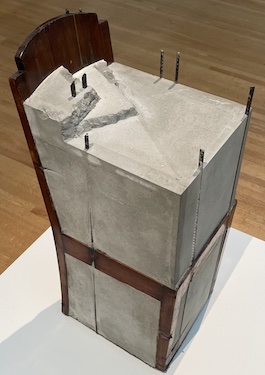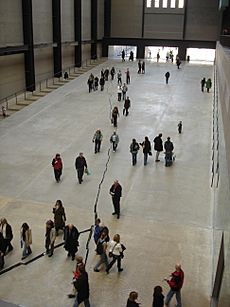Doris Salcedo facts for kids
Quick facts for kids
Doris Salcedo
|
|
|---|---|

Salcedo in 2015
|
|
| Born | 1958 (age 65–66) Bogota, Colombia
|
| Education | Jorge Tadeo Lozano University (BA) New York University (MFA) |
| Movement | Art as Activism |
| Awards | Guggenheim Fellowship (1995) The Ordway Prize, from the Penny McCall Foundation (2005) Commission from Tate Modern, London (2007) Velázquez Visual Arts Prize (2010) Hiroshima Art Prize (2014) |
Doris Salcedo (born 1958) is a Colombian-born visual artist and sculptor. Her work is influenced by her experiences of life in Colombia and is generally composed of commonplace items such as wooden furniture, clothing, concrete, grass, and rose petals. Salcedo's work gives form to pain, trauma, and loss, while creating space for individual and collective mourning. These themes stem from her own personal history. Members of her own family were among the many people who have disappeared in politically troubled Colombia. Much of her work deals with the fact that, while the death of a loved one can be mourned, their disappearance leaves an unbearable emptiness. Salcedo lives and works in Bogotá, Colombia.
Contents
Early life and education
Doris Salcedo was born in 1958 in Bogotá, Colombia. Salcedo completed a Bachelor of Fine Arts at Jorge Tadeo Lozano University in 1980, before traveling to New York City, where she completed a Master of Fine Arts degree at New York University in 1984. She then returned to Bogotá to teach at the Universidad Nacional de Colombia.
Art as repair

Doris Salcedo addresses the question of forgetting and memory in her installation artwork. In pieces such as Unland: The Orphan’s Tunic from 1997 and the La Casa Viuda series from the early 1990s, Salcedo takes ordinary household items, such as a chair and table, and transforms them into memorials for victims of the Civil War in Colombia.
In his book Present Pasts: Present Pasts: Urban Palimpsests and the Politics of Memory, Andreas Huyssen dedicates a chapter to Doris Salcedo and Unland: The Orphan’s Tunic, presenting her work as “Memory Sculpture.” Huyssen offers a detailed description of the piece, a seemingly mundane table that, when considered closely, “captures the viewer’s imagination in its unexpected, haunting visual and material presence.” A seemingly everyday piece of furniture is in fact made of two destroyed tables joined and covered with a whitish veil of fabric, presumably the orphan's original tunic. Upon even closer inspection, hundreds of small human hairs appear to be the thread that is attaching the tunic to the table. Huyssen equates the structure of the tables to the body. “If the tunic is like a skin…then the table gains a metaphoric presence as body, not now of an individual orphan but an orphaned community.” Salcedo's Unland is a memory sculpture, presenting the past of her own country of Colombia to the international art audience.
Again, in a 1998 interview with Charles Merewether, Salcedo expounds upon this notion of the metamorphosis, describing the experience of the viewer with her own artistic repair or restoration of the past. Salcedo employs objects from the past, objects imbued with an important sense of history and, through these contemporary memory sculptures, illustrates the flow of time. She joins the past and the present, repairs what she sees as incomplete and, in the eyes of Huyssen, presents “memory at the edge of an abyss…memory in the literal sense…and memory as process.”
Installations

Salcedo's work has become increasingly installation-based. She uses gallery spaces or unusual locations to create art and environments that are politically and historically charged. Noviembre 6 y 7 (2002) is a work commemorating the seventeenth anniversary of the violent seizing of the Supreme Court in Bogotá on November 6 and 7, 1985. Salcedo placed this piece in the new Palace of Justice. It took her over the course of 53 hours (the duration of the original siege) to place wooden chairs against the façade of the building being lowered from different points on its roof. Salcedo did this as creating “an act of memory”. Her goal was to re-inhabit the space that was forgotten.
In 2003, in a work she called Installation for the 8th Istanbul Biennial, she did an installation in a commonplace street consisting of 1,500 wooden chairs stacked precariously in the space between two buildings.
In 2005, at the Castello di Rivoli, Salcedo reworked one of the institution's major rooms by extending the existing vaulted brick ceiling of the gallery. Subtly transforming the existing space, Abyss was designed to evoke thoughts of incarceration and entombment.
In 2007, Salcedo became the eighth artist to have been commissioned to produce work for the Unilever turbine hall of the Tate Modern gallery in London for which she created Shibboleth, a 167-metre-long crack running the length of the hall's floor (pictured above) that Salcedo says "represents borders, the experience of immigrants, the experience of segregation, the experience of racial hatred. It is the experience of a Third World person coming into the heart of Europe". In this way her installation represented exclusion, separation and otherness.
Exhibitions
Salcedo has exhibited in group exhibitions internationally including Carnegie International (1995), XXIV São Paulo Biennial (1998), Trace, The Liverpool Biennial of Contemporary Art (1999), Documenta XI, Kassel (2002), 8th Istanbul Biennial (2003), ‘NeoHooDoo’, PS1 Contemporary Art Centre, New York, The Menil Collection, Houston (2008), ‘The New Décor’, Hayward Gallery, London (2010), and the Allen Memorial Art Museum at Oberlin College (2014–15). Solo exhibitions include The New Museum of Contemporary Art, New York (1998), San Francisco Museum of Modern Art (1999 and 2005), Tate Britain, London (1999), Camden Arts Centre, London (2001), White Cube, London (2004), Tate Modern, London (2007), The 80's: A Topology (2007), and Inhotim, Centro de Arte Contemporânea, Belo Horizonte, (2008). From April 2010 through February 2013, the artist's installation “plegaria Muda” traveled to museums throughout Europe and South America, including MUAC, Mexico; Moderna Museet, Malmö and CAM Gulbenkian, Lisbon (2011); MAXXI Rome and Pinacoteca São Paulo (2012), the Museum of Contemporary Art, Chicago (2015), and the Solomon R. Guggenheim Museum. (2015); and Harvard Art Museums (2016).
Recognition
- 1995 – Guggenheim Fellowship
- 2005 – The Ordway Prize, from the Penny McCall Foundation
- 2010 – Velázquez Visual Arts Prize
- 2014 – Hiroshima Art Prize
- 2016 – Inaugural Nasher Prize for Sculpture, Nasher Sculpture Center
- 2017 – Rolf Schock Prizes in Visual Arts
- 2019 – Nomura Art Award
Current research and themes
..... She regularly visits abandoned villages, murder sites, and mass graves. Salcedo reports that she has been doing much of the same research for many years with only small variations. For many years she kept files on concentration camps, these included both historical and more contemporary camps. She is most interested in how they vary from one another because they are always there just presented in different forms. Salcedo states that her one focus has always been political violence and the "Violence defines the evils of our society."
See also
 In Spanish: Doris Salcedo para niños
In Spanish: Doris Salcedo para niños
- Andreas Huyssen
- Repair
- Contemporary Art
- Dario Robleto

